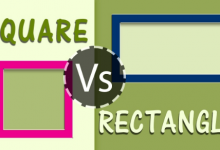What Shape is a Parallelogram but Not a Rhombus?
A parallelogram is a four-sided geometric shape where opposite sides are parallel to each other. This means that if two sides are parallel, so are the other two sides. A rhombus, on the other hand, is a specific type of parallelogram where all four sides have equal length. Therefore, a shape can be a parallelogram without being a rhombus.
A rectangle is a type of parallelogram where all angles are right angles (90 degrees). As opposite sides of a rectangle are parallel and congruent (of equal length), it is not a rhombus. A square is a specific type of rectangle where all four sides are congruent (of equal length). However, if a square has all four sides of congruent length then it is also a rhombus.
Another type of parallelogram that is not a rhombus is a trapezoid. A trapezoid has two parallel sides (the bases) and two non-parallel sides (the legs). The lengths of the bases can be different or equal but the opposite sides are not congruent. Therefore a trapezoid is a parallelogram but not a rhombus.
In conclusion, any four-sided shape that has opposite sides that are parallel but not congruent can be considered a parallelogram but not a rhombus. Examples of such shapes include rectangles, squares (if not a rhombus), and trapezoids.
